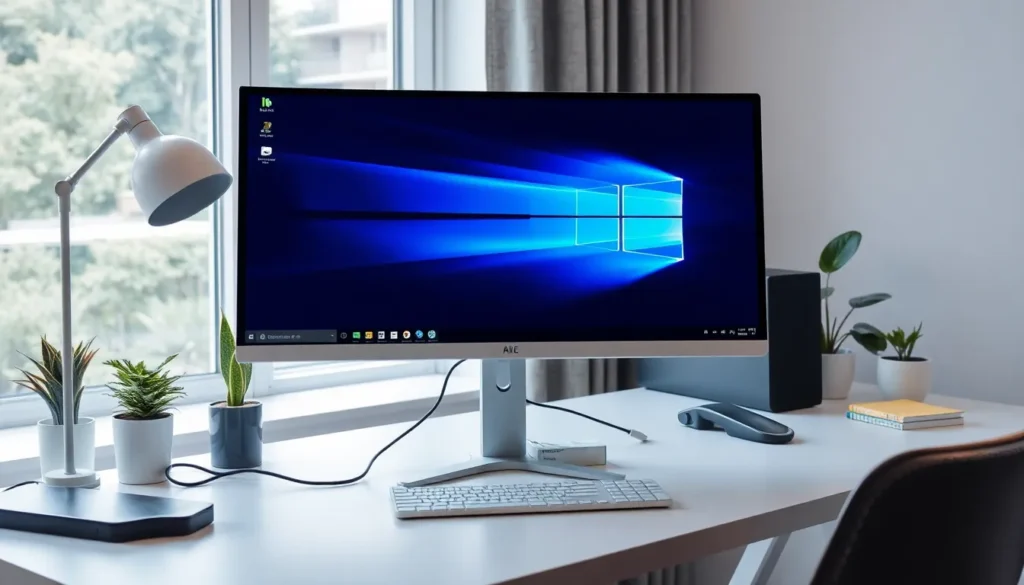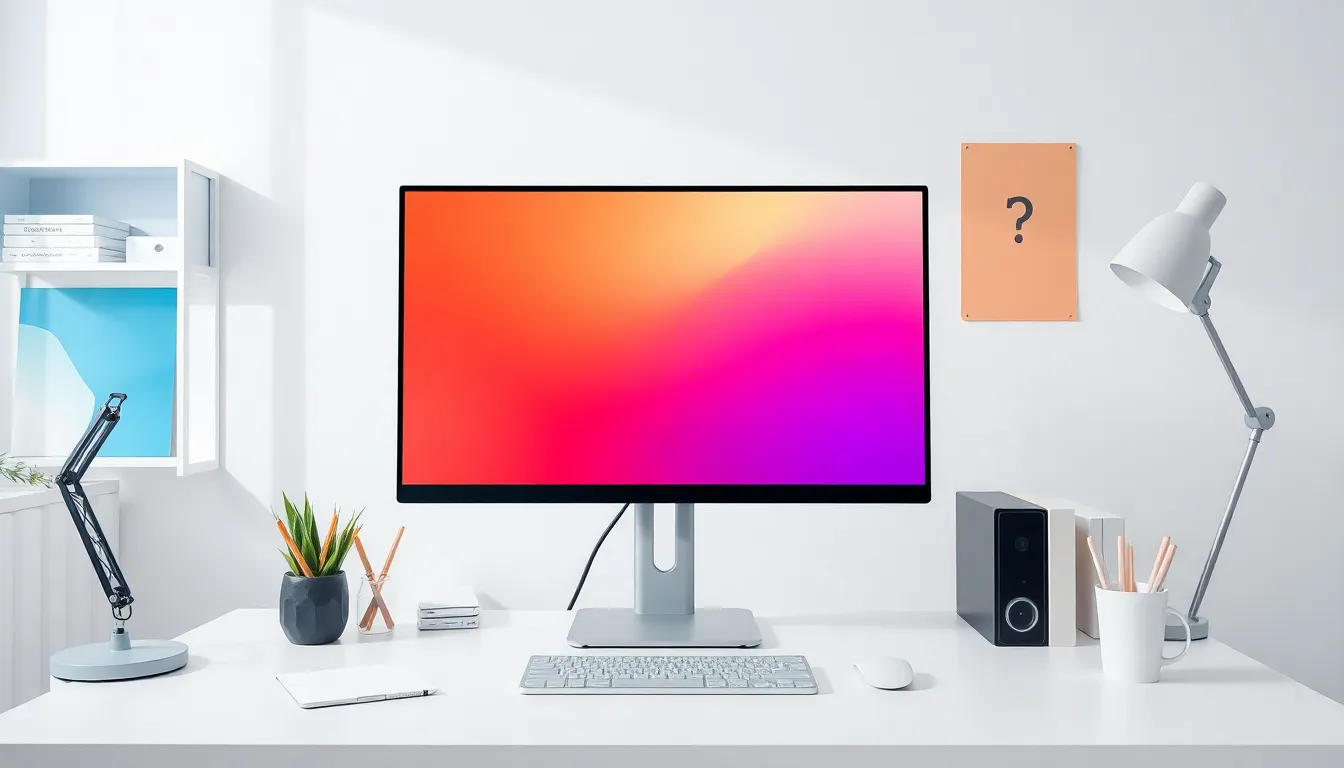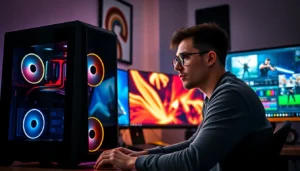
All-in-one computers have burst onto the scene like a surprise party—exciting yet slightly confusing. With everything packed into one sleek package, they promise a clutter-free workspace and a stylish look. But do they deliver the goods, or are they just a pretty face?
Imagine a world where your computer isn’t just a device but a conversation starter. It’s time to dive into the pros and cons of these tech marvels. Are they the ultimate solution for your computing needs, or do they leave you wishing for a more traditional setup? Buckle up as we explore whether all-in-one computers are truly the answer to your digital prayers or if they’re just another tech trend destined to collect dust.
Are All In One Computers Good
All-in-one computers combine the computer and monitor into a single unit, offering a space-saving solution. Many users appreciate this design for its aesthetic appeal and reduced cable clutter. Performance can vary by model, influenced by factors like processor type, RAM capacity, and storage options.
These machines typically feature modern components, meaning they often support advanced graphics and multitasking capabilities. Some all-in-one computers come equipped with touchscreens, adding an interactive element that enhances user experience.
Portability differs among models; while they are less mobile than laptops, some weigh less than traditional desktop setups. Price ranges fluctuate based on specifications, with entry-level models generally more affordable, appealing to budget-conscious consumers.
The main advantages include a streamlined workspace, integrated hardware, and low power usage. However, potential downsides exist, such as limited upgrade options and challenges with repairability.
Users seeking a consolidated workstation might find all-in-one computers suitable. Students or professionals working in smaller spaces also benefit from this compact design. While these devices present numerous perks, individuals must weigh specific needs against their features.
Advantages of All-In-One Computers

All-in-one computers offer several notable benefits that appeal to a variety of users. Their unique features cater to those looking for efficiency and aesthetic design.
Space-Saving Design
Innovative construction combines the monitor and computer into a single unit, making all-in-one computers ideal for limited spaces. Users appreciate this space-efficient design, which fits comfortably on smaller desks. Less footprint equals more room for essential items, promoting an organized workspace. Certain models even blend seamlessly with home décor, enhancing visual appeal. Compact size makes all-in-ones suitable for apartments and dorms, where maximizing available area proves crucial.
Simplified Setup
All-in-one computers come with an easy setup process, saving users time and hassle. A few simple connections get everything running, without the need for complex assembly. Plugging in power and internet cables often suffices to get started. New users especially find the straightforward installation refreshing and stress-free. Reduced setup time allows immediate focus on productivity and tasks.
Reduced Cable Clutter
Minimized cables characterize all-in-one computers, leading to a tidier workspace. Fewer cables mean reduced distractions and a cleaner aesthetic, enhancing the overall experience. Integrated components eliminate the need for multiple, tangled wires strung across the desk. Users value this lack of clutter, which simplifies cleaning and organization. A neat environment fosters better concentration and productivity, making all-in-one models appealing solutions.
Disadvantages of All-In-One Computers
All-in-one computers do come with several disadvantages that users should consider before making a purchase. These limitations can affect their overall utility and satisfaction.
Limited Upgrade Options
Limited upgrade options often restrict the lifespan of all-in-one computers. Many models do not allow for easy replacement of components like the graphics card or processor. Users attempting to enhance performance may find the process complicated or, in some cases, impossible. Generally, RAM upgrades are feasible, but storage expansion typically requires external solutions. This lack of flexibility may deter tech-savvy individuals who prioritize customization. Consequently, users seeking longevity in their devices may feel confined by these limitations.
Performance Issues
Performance issues can arise, particularly with entry-level models. Lower-end all-in-one computers may struggle to handle demanding tasks like video editing or gaming. Users may experience lags or slow response times when multitasking, especially with limited RAM or older processors. Overheating can also be a concern due to the compact design, which restricts airflow. These performance drawbacks may disappoint those who expect desktop capabilities from all-in-ones. As a result, understanding the performance capabilities of specific models becomes crucial for prospective buyers.
Comparison with Traditional Desktops
All-in-one computers present distinct differences compared to traditional desktops, especially in aspects like cost and performance.
Cost-Effectiveness
Cost effectiveness plays a crucial role in the decision-making process. Entry-level all-in-one computers often showcase competitive pricing, appealing to budget-conscious buyers. For those seeking a complete workstation, the expense includes both the computer and monitor, eliminating additional purchases. Traditional desktops typically require separate monitor costs, which can elevate overall spending. While high-end all-in-one models may approach traditional desktop prices, the integrated design reduces the need for extra components. Users prioritizing aesthetics alongside performance may find all-in-one devices more appealing for the price offered.
Performance Metrics
Performance metrics significantly differ between all-in-one computers and traditional desktops. Many entry-level all-in-ones struggle with demanding applications due to limited processing power. Users might notice slow response times during multitasking or high-resource activities, such as video editing or gaming. In contrast, traditional desktops often provide better upgrade pathways for components like RAM and graphics cards, enhancing performance longevity. Additionally, while some all-in-one models offer efficient configurations, many suffer from thermal management issues due to compact designs. Understanding these performance characteristics allows potential buyers to make informed choices based on their specific needs.
User Experiences and Reviews
Users frequently discuss the convenience of all-in-one computers, noting their streamlined design as a major advantage. Feedback from individuals in small living spaces highlights how these devices save precious desk space. Performance insights show a mixed bag; some users report satisfaction with efficiency for everyday tasks like browsing and document editing.
Many college students appreciate the ease of setup, often emphasizing that they plug in their all-in-one computer and get to work immediately. However, certain users express disappointment with entry-level models struggling under high-demand applications. Gaming enthusiasts, for instance, may find these models inadequate for graphics-intensive titles, leading to frustration.
Concerns about limited upgrade options arise in reviews as well. Tech-savvy individuals often share their desire for greater customization and flexibility in component replacement. Discussions about storage options reveal that while external solutions are available, they may not align with everyone’s preferences.
Several users mention overheating issues, particularly in compact designs. Overheating can impede multitasking efficiency, turning what should be a convenient machine into a source of annoyance. For those seeking a high-performance device, conversations suggest researching specific models thoroughly before purchasing.
All-in-one computers can be a great fit for those prioritizing space and aesthetics, but users emphasize the need for a good balance between form and function. Manufacturers must address performance challenges to satisfy a broader audience. Creating a clearer understanding of user expectations and experiences may help potential buyers gauge whether an all-in-one computer meets their needs effectively.
Conclusion
All-in-one computers certainly offer a unique blend of style and functionality that appeals to many users. Their compact design and ease of setup make them ideal for those with limited space or for individuals seeking a clutter-free workspace. However potential buyers must carefully consider their specific needs and the performance limitations of these devices.
While they shine in aesthetic appeal and convenience they may fall short in upgradeability and handling demanding tasks. Users should weigh the trade-offs between design and performance to ensure they choose a model that aligns with their requirements. Ultimately all-in-one computers can be a great choice for the right user but understanding their strengths and weaknesses is crucial for making an informed decision.








